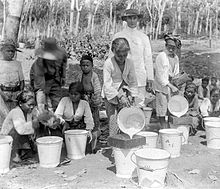- Cultivation System
-
This article is part of the
History of Indonesia series
See also:
Timeline of Indonesian History Prehistory Early kingdoms Kutai (4th century) Tarumanagara (358–669) Kalingga (6th–7th century) Srivijaya (7th–13th centuries) Sailendra (8th–9th centuries) Sunda Kingdom (669–1579) Medang Kingdom (752–1045) Kediri (1045–1221) Singhasari (1222–1292) Majapahit (1293–1500) The rise of Muslim states Spread of Islam (1200–1600) Sultanate of Ternate (1257–present) Malacca Sultanate (1400–1511) Sultanate of Demak (1475–1548) Aceh Sultanate (1496–1903) Sultanate of Banten (1526–1813) Mataram Sultanate (1500s–1700s) European colonialism The Portuguese (1512–1850) Dutch East India Co. (1602–1800) Dutch East Indies (1800–1942) The emergence of Indonesia National awakening (1899–1942) Japanese occupation (1942–45) National revolution (1945–50) Independent Indonesia Liberal democracy (1950–57) Guided Democracy (1957–65) Start of the New Order (1965–66) The New Order (1966–98) Reformasi era (1998–present) The Cultivation System (Dutch: cultuurstelsel), or less accurately the Culture System, was a Dutch government policy in the mid-nineteenth century for its Dutch East Indies colony (now Indonesia). Requiring a portion of agricultural production to be devoted to export crops, Indonesian historians refer to it as Tanam Paksa ("Compulsory Planting").
Contents
Background
Despite increasing returns from the Dutch system of land tax, Dutch finances had been severely affected by the cost of the Java War and Padri Wars. The Dutch loss of Belgium in 1830 brought the Netherlands to the brink of bankruptcy, and a concerted Dutch exploitation of Indonesian resources commenced to make quick returns. In 1830, a new governor general, Johannes van den Bosch, was appointed to make the Dutch East Indies pay their way.
Implementation and effects
 Collecting natural rubbers in plantation in Java. Rubber tree was introduced by the Dutch from South America.
Collecting natural rubbers in plantation in Java. Rubber tree was introduced by the Dutch from South America.
It was primarily implemented in Java, the center of the colonial state. Instead of land taxes, 20% of village land had to be devoted to government crops for export, or alternatively, peasants had to work in government-owned plantations for 60 days of the year. In order to allow the enforcement of these policies, Javanese villagers were more formally linked to their villages, and were sometimes prevented from travelling freely around the island without permission. As a result of this policy, much of Java became a Dutch plantation.
In order to handle and process the cash crops, the Dutch set up a network of local middlemen who profited greatly and so had a vested interest in the system, compradores somewhat like the cottier system in Ireland. This was financed partly by bonds sold to the Dutch themselves, and partly by introducing a new copper coinage at about a 2:1 ratio to the old, thereby gaining a massive seigneurage from the depreciation at the expense of the local economy. From Section 5 of Some Notes on Java and its Administration by the Dutch, by Henry Scott Boys, Late Bengal Civil Service, Allahabad: Pioneer Press, 1892:-
'An ingenious device for increasing the Government profit was devised by General Van-der Bosch at the same time as he initiated the culture system. An enormous amount of copper coinage was manufactured in Holland, the intrinsic value being rather less than half the nominal value. This coinage was made a legal tender, and the cultivator was paid for his produce in this copper coin. Thus, as Mr. Money in his work Java; or, How to Manage a Colony, naively remarks:- "The loans, raised in Holland to start the system, produced an effect in Java equal to double their amount."'
The policy brought the Dutch and their Indonesian allies enormous wealth through export growth, averaging around fourteen percent. It brought the Netherlands back from the brink of bankruptcy and made the Dutch East Indies self-sufficient and profitable. The Cultivation system is widely linked, however, to greatly increased hunger and poverty on Java in the late nineteenth century. Cash crops such as indigo and sugar, had to be grown instead of rice, and Java suffered famines and epidemics in the 1840s, firstly in Cirebon and then Central Java.
Political pressures in the Netherlands resulting partly from these problems, and partly from rent seeking independent merchants who wished to share in the gains from development under the seemingly altruistic guise of free trade or local preference (see the Henry Scott Boys work mentioned above), eventually led to its abolition (circa 1870) and replacement with free-market Liberal Period whereby private enterprise was encouraged.
The impact of the cultivation system on the standard of living of indigenous Javanese has in recent years been disputed. R.E. Elson, among others, has argued that the cultivation system directly contributed to the impoverishment of Javanese peasants, but indirectly improved their standard of living.[citation needed]
See also
References
- Witton, Patrick (2003). Indonesia. Melbourne: Lonely Planet. pp. 23–24. ISBN 1-74059-154-2.
- Boys, Henry Scott (1892). Some Notes on Java and its Administration by the Dutch. Allahabad: Pioneer Press. Section 5.
Further reading
- Ricklefs, M.C. (1991). A Modern History of Indonesia, 2nd edition. MacMillan. pp. 119–24, 126, 128. ISBN 0-333-57690-X.
Categories:- Dutch East Indies
- Colonialism
- Economic history of Indonesia
Wikimedia Foundation. 2010.

